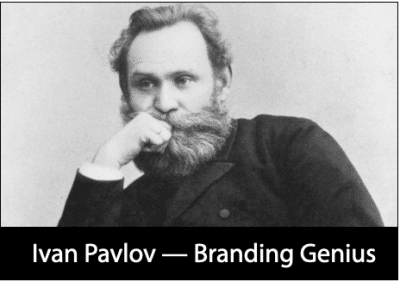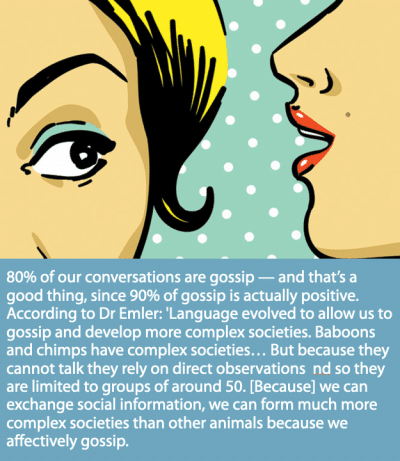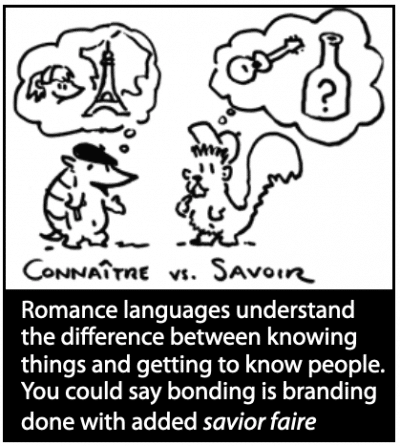
Bonding is a type of branding.
All bonding is branding. But most branding isn’t bonding.
Though it’s not as if bonding is at all new. It’s just that it fell out of fashion and normally isn’t done with the needed level of intention and skill.
 So here’s how to distinguish bonding from branding:
So here’s how to distinguish bonding from branding:
Branding is creating an association in the mind of customers between the brand and positive qualities and benefits through classical conditioning.
When I say the word Porsche, you probably reflexively think some variation of:
“sports car, German, distinctive looking, 911, rear-engine, fast, expensive”
And I emphasize that your recall is a reflexive reaction, just like Pavlov’s dogs’ bell-induced drooling.
 Bonding is simply a more elegant version of branding that takes advantage of humans’ hardwired preoccupation with other humans.
Bonding is simply a more elegant version of branding that takes advantage of humans’ hardwired preoccupation with other humans.
The vast majority of our attention, awareness, and thinking involves social cognition — to the point that cognitive scientists know that our default neural network is innately focused on understanding intention and state-of-mind for fellow humans.
And social scientists estimate that 80% of our conversations are, in fact, gossip.
Think about that: four fifths of what we talk about is other people.
We are hardwired to form estimations and judgements of other people, even other people we’ve never personally met.
In fact, this very ability to gossips is why we’re able to form much bigger communities thanother primates.
 So why shouldn’t advertising use that rather than ignoring it?
So why shouldn’t advertising use that rather than ignoring it?
Instead of forming an associative memory about a faceless organization, bonding presents the public with a brand spokesperson.
Instead of ads aimed at transferring information that the company wishes you to know, bonding ads present a person that you are hardwired to want to get to know.
It makes the whole process faster and easier, relying less on sheer repetition and more on hardwired psychology.
This is why Ben and Jerry’s has a stronger brand than Häagen-Dazs. But it’s also why…
-
- We prefer to get our pancakes from Aunt Jemima
- We want Betty Crocker’s help in making our cakes
- Tony the Tiger guarantees our Frosted Flakes will taste Grrreat!
- The Colonel ensures our fried chicken is Finger Lickin’ Good.
- Frank Perdue’s seal approval means a tender chicken.
- And why Columbia’s Tough Mother spiked sales after promising to ensure top-quality in every product.
Basically, people prefer to buy from other people, rather than faceless corporations.
And while there’s definitely an element of “Willing Suspension of Disbelief” when conjuring up a spokesperson for a big corporate brand, bonding get’s much more authentic when dealing with owner-operated businesses.
When the owner is the spokesperson and the buck really does stop at his or her desk, the whole process of inducing the audience to estimate the owner’s character becomes much easier and faster.
Bonding Affects Every Other Advertising Decision
So other than having a spokesperson (or anthropomorphized mascot), what else changes between bonding and more generic branding?
First, bonding works best when attracting relational rather than transactional customers.
If your goal is to be the low-priced leader, bonding probably ain’t the right strategy.
Second, the spokesperson has to be a defined character rather than just a generic announcer or “person.”
Hence the reason to use a Character Diamond and treat the person like a movie character.
And why you’ll want a brand voice guide focused on world-building more than grammar.
The ads will also need to speak to the audience, rather than at them.
Rather than having a single slogan, used robotically in the same place every single time, your real-live character will want to have go-to phrases, used organically, off-and-on, in whatever spots make sense.
Moreover, you’ll want to use the same language on your website and on the phone and in-person as in your ads.
Real people don’t have have split personalities, at least not anyone that other’s would trust.
And it’ll be best, at some point, to reveal elements of the owners’ background and genesis story.
People will want to know a bit about you, and how you came to be in the business you’re in along with the “why” behind what you do.
And ultimately, your ads will end up focusing as much on your values as on your offerings.
Bonding Requires Commitment and Proper Execution
So choosing bonding over more generic branding isn’t a decision to be made lightly, nor is it something that can just be tacked-on to a campaign or marketing strategy.
As you can see, this is a decision to be made at the ground level and baked into everything else you’re doing in your marketing.
But it’s worth it. Bonding accelerates advertising results and blows the doors off of regular branding.
And as with anything of great power, control is paramount.
 We all know that the greater the power, the harder the control.
We all know that the greater the power, the harder the control.
And in advertising that means execution becomes paramount.
Any fool can write an announcer-read spot full of copy points. That’s why 90% of the ads you hear fall into that style.
Crafting a defined character and consistently speaking in his voice and creating a relationship with the audience takes talent.
So if you choose to bond — and if you’re a local, service-based business, you probably should — make sure you choose a team that can pull it off.
P.S. If you’re intrigued by bonding and want to learn more, I recommend this Wizard Academy course on Origin Stories. Origin stories are a go-to tool for bonding campaigns.
Full Disclosure, I’m teaching the course, but my pay isn’t tied to enrollment. I’m only mentioning it for transparency’s sake and to explain why I can offer you a 30% discount for using the code “jeffsentme”
- Getting a Foot in the Door — Of Perception - November 27, 2025
- What Digital Superstars Know About Offline Advertising - November 17, 2025
- Unmistakable: A Tale of Two Boots and Branding Done Right - November 8, 2025
